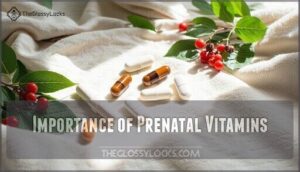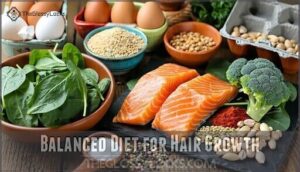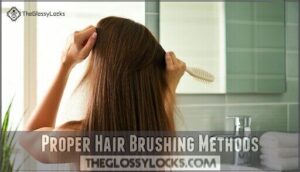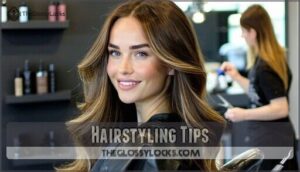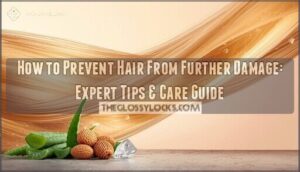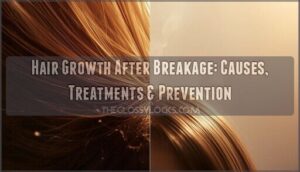This site is supported by our readers. We may earn a commission, at no cost to you, if you purchase through links.
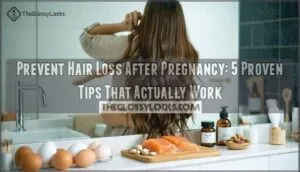 You can’t completely stop postpartum hair loss, but you can minimize it and support healthy regrowth.
You can’t completely stop postpartum hair loss, but you can minimize it and support healthy regrowth.
This temporary shedding happens because pregnancy hormones that kept your hair thick suddenly drop after delivery, causing three to six months of increased hair fall.
Focus on gentle hair care, maintain your prenatal vitamins, eat protein-rich foods, manage stress through rest and support, and avoid tight hairstyles that pull on fragile strands.
Most women see their hair return to normal thickness within six to twelve months as hormones stabilize. The key lies in understanding which specific nutrients your recovering body needs most and how simple styling changes can make a dramatic difference.
Table Of Contents
- Key Takeaways
- Hair Loss After Pregnancy
- Nutritional Strategies
- Gentle Hair Care Practices
- Hairstyling Tips
- Lifestyle Adjustments
- Frequently Asked Questions (FAQs)
- How can I prevent postpartum hair loss?
- How can I prevent hair loss during pregnancy?
- Is it normal for my hair to thin out after pregnancy?
- Can a healthy diet prevent postpartum hair loss?
- Can I lose hair if I’m Pregnant?
- What causes hair loss during pregnancy & postpartum?
- Is Your Postpartum Hair Loss Normal?
- How can I prevent hair loss after pregnancy?
- How can I help female hair loss?
- Can you prevent postpartum hair loss?
- Conclusion
Key Takeaways
- You can’t prevent postpartum hair loss completely since it’s hormonally driven, but you’ll minimize shedding through gentle care, proper nutrition, and stress management during this temporary 3-6 month phase.
- Continue taking prenatal vitamins and eat protein-rich foods with iron, biotin, and omega-3s to support your hair’s recovery and provide essential building blocks for regrowth.
- Use sulfate-free shampoos, avoid tight hairstyles, and treat your hair gently since it’s especially fragile during postpartum recovery – harsh treatments will worsen the shedding.
- Manage chronic stress through adequate sleep, light exercise, and support networks since chronic stress elevates cortisol levels that disrupt your hair’s natural growth cycle and delay recovery.
Hair Loss After Pregnancy
You’ll experience significant hair shedding around three to six months after giving birth due to dramatic hormonal shifts that affect your hair’s natural growth cycle.
While this postpartum hair loss feels alarming, it’s completely normal and temporary, with most women seeing their hair return to its pre-pregnancy state within 12 to 18 months, which is a temporary condition.
Hormonal Changes Cause Hair Loss
Your body undergoes dramatic hormonal changes after delivery that directly trigger postpartum hair loss.
Your hair follicles shift into overdrive during pregnancy, then dramatically reverse course after delivery.
Estrogen decline shifts hair follicles from growth to resting phase, while progesterone impact and fluctuating androgen levels compound the shedding.
Thyroid imbalance affects nearly 10% of new mothers, worsening hormonal changes and hair thinning during postpartum recovery.
Normal Hair Shedding Timeline
Your hair’s shedding follows a predictable pattern after childbirth.
Here’s what you can expect during your postpartum hair loss journey:
- Peak Shedding Period: Hair loss typically intensifies between 3-6 months postpartum, when telogen effluvium reaches its maximum
- Shedding Duration: Most women experience noticeable hair shedding postpartum for 6-12 months before stabilizing
- Regrowth Expectations: Hair regrowth postpartum usually begins around 12-18 months, though individual variation affects timing substantially
Differentiating Normal and Excessive Loss
Three key indicators separate normal hair loss postpartum from concerning patterns.
Normal shedding peaks at 200 hairs daily around four months, while excessive loss creates bald patches or clumps.
Watch for widening part lines, visible scalp areas, or persistent hair thinning postpartum beyond twelve months.
These shedding patterns signal underlying conditions requiring seeking professional evaluation, as postpartum alopecia’s psychological impact shouldn’t be underestimated.
This is often caused by hormonal changes after giving birth, which can lead to postpartum alopecia and have a significant impact on the mother’s well-being, making it essential to recognize excessive loss and persistent hair thinning.
Nutritional Strategies
What you eat directly impacts your hair’s ability to recover from postpartum shedding, making nutrition your most powerful tool for regrowth.
The right combination of vitamins, minerals, and proteins can substantially speed up your hair’s return to its pre-pregnancy thickness.
Essential Nutrients for Hair Health
Fueling your follicles starts with the right building blocks.
Proteins supply keratin for stronger strands, while vitamins and minerals like iron and zinc support cellular renewal.
Healthy fats maintain follicle hydration, preventing brittle hair shafts.
When nutrient deficiency strikes, hair loss postpartum accelerates—but proper nutrition for hair can restore your crowning glory naturally.
Many women also find that hair growth supplements can provide extra support to help with hair growth and hair loss, leading to stronger and healthier hair shafts.
Importance of Prenatal Vitamins
Continuing your nutritional foundation, prenatal vitamins serve as your safety net for hair loss prevention during the postpartum period.
These supplements bridge nutritional gaps that occur naturally after pregnancy and breastfeeding.
Key postpartum hair vitamins include:
- Folic Acid – supports cellular regeneration and healthy hair follicle function
- Biotin Benefits – strengthens hair shaft structure and reduces breakage substantially
- Vitamin D – regulates hair growth cycles and prevents excessive shedding
- Iron Intake – prevents anemia-related hair loss common in new mothers.
Omega-3s also support scalp health and reduce inflammation that contributes to pregnancy hair loss.
Some may also consider using vitamin C for benefits to boost collagen production, improving overall hair health.
Balanced Diet for Hair Growth
While prenatal vitamins provide foundational support, your daily meals pack the real nutritional punch for combating postpartum hair loss.
Focus on protein intake through lean meats, eggs, and legumes, which supply building blocks for strong strands. Iron sources like spinach and red meat prevent deficiency-related shedding, while vitamin D from fatty fish supports follicle health.
You can explore options for protein-based hair products to supplement your diet.
| Nutrient | Hair Growth Benefits |
|---|---|
| Protein Intake | Strengthens hair structure and prevents breakage |
| Iron Sources | Prevents anemia-related hair thinning |
| Vitamin D | Activates hair follicles for new growth |
| Omega-3s | Reduces inflammation and adds shine |
Your gut health directly impacts nutrient absorption, so include fermented foods and fiber-rich vegetables. This thorough approach to hair growth nutrition guarantees your body receives what it needs for superior postpartum nutrition and vitamins for hair growth.
Hydration Role in Hair Health
Beyond nutrition, Water Intake directly impacts your hair’s recovery. Dehydration affects Scalp Hydration, slowing postpartum hair growth.
Watch for Hydration Symptoms like brittle strands or flaky scalp—these signal your hair needs more moisture. Many find that hydrating hair products can assist in this process.
Hydration Benefits for postpartum hair care:
- Improves blood flow to hair follicles
- Maintains scalp moisture balance
- Supports nutrient delivery to roots
- Reduces hair breakage and brittleness
- Promotes faster hair health recovery.
Aim for Ideal Hydration—eight glasses daily prevents hair loss complications.
Gentle Hair Care Practices
Your hair becomes especially vulnerable during the postpartum period, requiring extra care to minimize breakage and support healthy regrowth.
Treat your fragile postpartum hair like delicate silk—gentle care now prevents permanent damage later.
Simple adjustments to your daily hair routine can substantially reduce further loss while your hormones stabilize.
Gentle Washing and Drying Techniques
Your hair care routine needs gentle handling when you’re managing postpartum hair shedding.
Wash your hair twice weekly with lukewarm water to maintain scalp health without overstimulating sebaceous glands.
Apply conditioner from mid-length to ends, avoiding roots where Product Application can weigh down fragile strands.
After washing, gently squeeze excess water using a microfiber towel instead of rough Towel Drying motions that stress weakened follicles, promoting gentle hair care.
Choosing Right Hair Care Products
What makes the difference between hair that bounces back and hair that breaks?
Selecting the right products for your hair type and postpartum needs creates a foundation for healthy regrowth.
- Sulfate-free shampoos reduce breakage by 76% according to dermatologists
- Natural ingredients like biotin and panthenol boost scalp health substantially
- Product reviews help identify hypoallergenic, fragrance-free formulas
- Hair type matters—fine hair needs lightweight volumizers, curly hair requires moisture-rich treatments
- Postpartum hair treatment products with keratin show 40% strength improvement
Avoiding Harsh Chemicals and Heat
Protect your vulnerable strands by ditching damaging treatments that can worsen postpartum hair loss.
Chemical processes and excessive heat create additional stress on already fragile follicles, slowing your hair’s natural recovery process.
One way to avoid harsh chemicals is to explore organic hair treatment options for a gentler approach.
| Avoid These Damaging Practices | Use These Gentle Alternatives |
|---|---|
| Chemical relaxers and perms | Gentle Perms with conditioning treatments |
| Bleaching and harsh dyes | Natural Dyes like henna or semi-permanent colors |
| Daily blow-drying on high heat | Heat Styling Alternatives like air-drying or cool settings |
| Chemical-laden styling products | Chemical-Free Products with natural ingredients and Protective Sprays |
Your hair care after pregnancy requires extra patience and gentleness to support postpartum recovery and effective hair loss prevention.
Proper Hair Brushing Methods
The right brush material makes all the difference when combating postpartum hair loss.
Choose natural boar bristles or wide-tooth combs that won’t snap fragile strands during your hair recovery journey.
- Select gentle brush material: Natural boar bristles distribute oils without breaking weakened postpartum hair
- Limit brushing frequency: Brush only when necessary to minimize hair loss after birth
- Master detangling techniques: Start from ends, working upward to prevent breakage during hair care after pregnancy
- Include scalp stimulation: Gentle circular motions promote postpartum hair growth through increased circulation
- Maintain brush cleaning: Weekly cleaning prevents bacteria buildup that could hinder postpartum hair recovery
Hairstyling Tips
You can prevent hair loss from becoming more noticeable by choosing the right hairstyles and products that work with your changing hair.
Smart styling choices help you maintain confidence while your hair naturally recovers from postpartum hormonal shifts, which is crucial for overall well-being.
Haircuts for Volume and Thickness
During postpartum recovery, strategic cuts create the illusion of fuller locks.
Layered cuts add movement and dimension, while blunt cuts provide density appearance.
Bob variations work well for thinning areas, and pixie cuts offer easy maintenance.
Consider bang styles to frame your face and distract from hair loss after birth.
| Cut Type | Volume Benefits | Best For |
|---|---|---|
| Layered cuts | Creates movement, adds texture | Medium to long hair with postpartum hair loss |
| Blunt cuts | Provides density appearance | Fine hair needing thickness illusion |
| Bob variations | Concentrates hair at jawline | Overall thinning, easy styling |
| Pixie cuts | Minimizes hair loss visibility | Severe postpartum hair growth issues |
Avoiding Tight Hairstyles and Accessories
Tight ponytails and restrictive headbands create unnecessary headband pressure and ponytail damage during this vulnerable period.
Instead of harsh clips, explore gentler clip alternatives like silk scrunchies or loose fabric ties.
Consider braid tension carefully—if your scalp feels pulled, it’s too tight.
For severe thinning, wig considerations might help maintain confidence while implementing these healthy hair postpartum strategies and essential postpartum hair loss prevention techniques.
Using Volumizing Products Effectively
Volumizing products can transform thin postpartum hair, but product application matters more than brand names.
Choose lightweight mousses over heavy creams to avoid weighing down fragile strands.
Ingredient analysis reveals that rice protein and biotin boost volume naturally.
Avoid product overuse—a quarter-sized amount covers most heads.
Focus on scalp health by applying products mid-shaft down, never directly on roots.
Strategic product pairing maximizes results.
For added lift, consider root-lifting sprays.
Temporary Solutions for Hair Loss
Don’t let thinning strands dim your confidence—clever camouflage techniques can instantly restore your hair’s appearance while you wait for regrowth.
These temporary hair loss remedies offer immediate results without damaging your recovering follicles.
- Topical scalp concealers and fiber sprays provide instant coverage, with water-resistant formulations lasting up-to 24 hours
- Hair extensions and clip-in toppers add volume without permanent commitment or scalp stress
- Strategic styling techniques using volumizing products create fuller appearance through layered cuts and texturizing sprays
Lifestyle Adjustments
Your body’s working overtime adjusting to new demands, and this stress directly impacts your hair’s growth cycle.
Creating healthier daily routines can substantially improve your hair’s recovery and give you more energy to handle the beautiful chaos of motherhood.
Stress Management for New Mothers
Managing anxiety becomes essential since chronic stress directly contributes to postpartum hair loss by disrupting your hair’s natural growth cycle.
Practice mindfulness techniques like deep breathing exercises during feeding times, and establish realistic time management strategies that prioritize your emotional wellbeing.
Simple relaxation exercises, even five-minute meditation sessions, can substantially reduce postpartum stress and support healthy hair regrowth through improved hormonal balance, which aids in hair regrowth.
Importance of Sleep for Hair Health
Your body’s repair mode kicks in during sleep, making those precious hours essential for combating postpartum hair loss.
Sleep deprivation disrupts melatonin production, which regulates hair growth cycles and reduces scalp circulation.
When you’re well-rested, your body focuses energy on hair follicle repair and stress reduction, giving your locks the best chance to bounce back naturally.
Managing Postpartum Stress and Anxiety
You’re juggling diaper changes, feeding schedules, and sleepless nights—it’s no wonder stress feels overwhelming.
Chronic postpartum stress accelerates postpartum hair loss by elevating cortisol levels, which disrupts hair growth cycles.
Effective postpartum stress management includes therapy options like cognitive-behavioral therapy, building support networks, practicing mindfulness techniques, ensuring medication safety with healthcare providers, and encouraging partner involvement in daily care routines.
Promoting Overall Health for Hair Regrowth
Your body’s foundation determines how well your hair can bounce back from postpartum changes.
Supporting overall health creates the ideal environment for hair regrowth, addressing root causes rather than just symptoms.
- Gut health: Probiotics and fiber-rich foods improve nutrient absorption for stronger hair follicles
- Exercise benefits: Light movement boosts circulation, delivering oxygen to hair roots
- Hormonal balance: Quality sleep and stress reduction help stabilize hair growth cycles
- Detoxification methods: Adequate water intake flushes toxins that can impede hair growth
- Mental wellness: Managing postpartum stress prevents cortisol spikes that worsen hair loss
Frequently Asked Questions (FAQs)
How can I prevent postpartum hair loss?
You can’t completely prevent postpartum hair loss since it’s a natural hormonal process, but you can minimize it.
Maintain a balanced diet rich in protein, iron, and vitamins, continue prenatal vitamins while breastfeeding, and use gentle hair care routines.
How can I prevent hair loss during pregnancy?
You can’t completely prevent pregnancy hair loss, but you’ll minimize it by eating protein-rich foods, taking prenatal vitamins, avoiding tight hairstyles, and using gentle hair care products.
Is it normal for my hair to thin out after pregnancy?
Yes, it’s completely normal for your hair to thin after pregnancy.
Hormonal changes cause telogen effluvium, where hair enters a resting phase and sheds more than usual.
This temporary hair loss typically peaks around three to six months postpartum and gradually improves, which is a normal part of the postpartum process.
Can a healthy diet prevent postpartum hair loss?
Ironically, while you can’t completely prevent nature’s postpartum hair shedding process, you can minimize its severity.
A nutrient-rich diet with adequate protein, iron, and vitamins won’t stop hormonal changes but supports healthier regrowth and reduces excessive loss.
Can I lose hair if I’m Pregnant?
During pregnancy, you’ll likely experience hair changes, but significant hair loss isn’t typical.
Your hormones actually boost hair growth and thickness.
However, you might notice some thinning or texture changes as your body adjusts to hormonal shifts throughout pregnancy.
What causes hair loss during pregnancy & postpartum?
Your hormones wreak havoc on your hair follicles during this journey.
Estrogen and progesterone levels fluctuate dramatically, causing hair to grow thicker during pregnancy, then shed rapidly postpartum as levels drop.
Is Your Postpartum Hair Loss Normal?
That "thinning crown" you’re experiencing isn’t just your imagination running wild.
Postpartum hair thinning or hair loss, known as telogen effluvium, is a common condition that occurs when hormone levels drop back to their regular levels after childbirth.
You’ll typically notice this hair loss starting around three to four months after delivery, and it’s completely normal for new mothers.
How can I prevent hair loss after pregnancy?
You can’t completely prevent postpartum hair loss since it’s natural, but gentle hair care helps minimize it. Use sulfate-free shampoos, avoid tight hairstyles, eat protein-rich foods, and consider prenatal vitamins.
How can I help female hair loss?
Losing your locks can feel like watching your identity slip away strand by strand.
You can tackle female hair loss by maintaining balanced nutrition, managing stress levels, using gentle hair care products, considering minoxidil treatments, and consulting a dermatologist for personalized solutions.
Can you prevent postpartum hair loss?
You can’t completely prevent postpartum hair loss since it’s hormonally driven, but you’ll minimize it through gentle care, proper nutrition, prenatal vitamins, stress management, and avoiding harsh styling treatments.
Conclusion
Remember when telegraph operators charged by the word? You’ll want every strand to count as you prevent hair loss after pregnancy through these proven strategies.
Your postpartum hair journey doesn’t have to feel overwhelming when you’re armed with the right knowledge and tools. Gentle care, proper nutrition, stress management, and smart styling choices work together to support your hair’s natural recovery process.
While complete prevention isn’t possible, these evidence-based approaches substantially minimize shedding and promote faster regrowth during this temporary phase, utilizing gentle care and proper nutrition to aid in the process.
- https://kairahaircare.com/blogs/articles/postpartum-hair-loss-vs-normal-hair-fall
- https://zieringmedical.com/blog/postpartum-hair-loss-new-moms-guide/
- https://www.naturalcycles.com/cyclematters/postpartum-hair-loss
- https://www.michelegreenmd.com/postpartum-hair-loss
- https://www2.hse.ie/pregnancy-birth/birth/health-after-birth/breast-changes-hair-loss/


